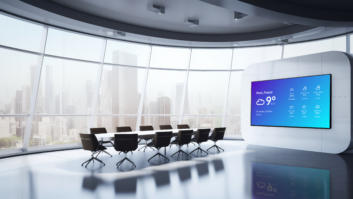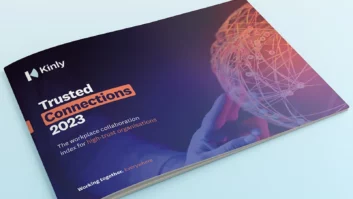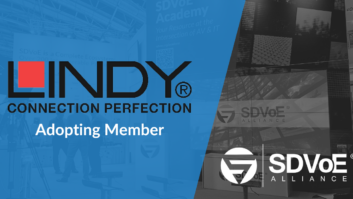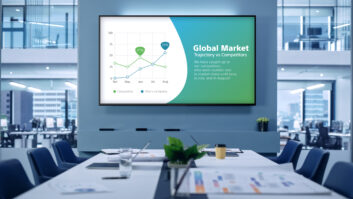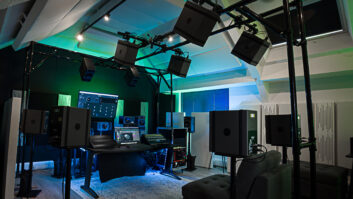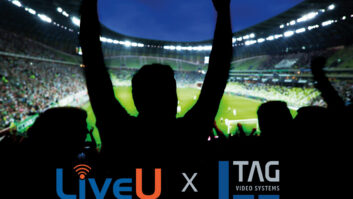
Oblong’s Mezzanine is a collaboration platform that lets meeting participants get hands-on with their data – whether they’re present physically or virtually. Paddy Baker had a demonstration.
Many technology companies have their beginnings in academic research, before moving on to full commercialisation. Rather fewer companies can point to work on Hollywood movies as an intermediate stage – but Oblong Industries can do just that. Company founder and chief scientist John Underkoffler was working at MIT Media Lab in the mid-1990s, and a few years later designed the computer interfaces for Minority Report – a film that still gets cited today as a benchmark for interactive displays and interfaces.
Oblong’s Mezzanine collaboration solution isn’t identical to what Tom Cruise and his Pre-Crime colleagues used, but what it does have in common is the use of a gestural interface to navigate one’s way through large amounts of documents and data in a structured, collaborative way. It can be used for meetings where everyone is present in the room, or by dispersed teams in a number of locations.
A Mezzanine room set-up consists of two sets of displays: the ‘workspace’, which is visible to all session participants, and the ‘corkboards’ which are not shared beyond the room. The workspace was previously known as the triptych, as its most popular form is three displays side by side in portrait mode: however, other configurations can be used.
One of the strengths of Mezzanine is the way everything is referenced visually. So static images – which could be photos or could just as easily be dynamic screenshots of spreadsheets or Word documents – reside in the ‘dock’ at the top of the screen. Video sources – which could be videoconferencing sessions, or a feed from a whiteboard camera or a handheld device – reside at the bottom of the screen. Any items from either area can be dragged into the presentation space, which fills the centre area of the displays and can then be maximised to fill a workspace screen. It’s a simple matter of scrolling through to find what you need at any given time.
Another working area is the ‘windshield’ – a semi-transparent layer, sitting in front of the main workspace, onto which graphics can be called up and worked on – for example, pulling up a hi-res architectural plan and cropping out the area of interest.
Apart from the displays, Mezzanine consists of a 4U appliance, ultrasonic controller wands and a tracking array (typically mounted on the ceiling) which detects the wands’ motion. Other devices can be integrated, such as videoconferencing codecs or audio equipment. Retrofitting Mezzanine into existing facilities enables existing equipment to be redeployed.
According to sales director Steve Smith, people who see a Mezzanine wand for the first time sometimes compare it to a Wii remote, which he feels is unfair: “It’s like calling Harrods a corner shop.” Smith demonstrated the system to me and explained that the small repertoire of movements needed to operate it is easily learned. I tried out the wand under his instruction and found I could zoom in and out, swipe. select, drag and crop – and I can well believe that these gestural movements soon become second nature. Alternatively, Mezzanine can be operated via tablet.
Smith explained that there are three broad types of use case for Mezzanine. The first is enhancing the customer experience – for instance by incorporating live data into a presentation, or using the corkboards for secondary information (for instance, as flashcards) that supplement the main display.
The second use case is making meetings work more effectively – for instance in project-based working. Having visual information visible to everyone at once makes it easier to make decisions at the meeting rather than offline. Mezzanine also provides the facility to create timestamped notes detailing what has been decided.
The third broad use case is ‘situational awareness’ – using real-time data to make quick decisions. “It’s not a control room technology, but it’s maybe for the room next door to the control room,” said Smith. “Control rooms use lots of sources but tend to be quite rigid in structure.”
Smith demonstrated how Mezzanine might be used in an architectural meeting – watch the video here:
[brightcove videoid=”3779720362001″ playerid=”3033416250001″ height=”270″ width=”480″]
Oblong has conducted studies that suggest that the technology can cut meeting times by up to 25%. Everyone can load their documents into the dock at the start of the meeting – and the system saves these into ‘dossiers’ which can be revisited over time. A Mezzanine system can support up to 32 devices – either in the room or remotely – with up to 10 of them able to have control of the Mezzanine session.
It obviously depends on the use case, but it’s easy to imagine scenarios where this technology would enable options to be explored and data to be interrogated on the spot, so that decisions can be taken there and then in the meeting rather than deferred pending further work. To support this, the system has a function where decisions taken can be noted and signed off by the relevant participants.
Mezzanine has an impressive client roster, including IBM, Boeing, GE, Sonos and Beats, as well as universities and government organisations. On the evidence of this demo, it looks set to increase this dramatically.
